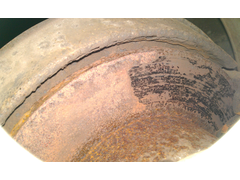
shiney surface flaking off a brake disc?
blakep82 - 1/10/13 at 04:01 PM
no, while i know this disc is an a pretty poor state (when i got the car, it looked like the pad hadn't touched the disc in a VERY long time, and
the disc was pitted.
i cleaned up the caliper, sliders, etc, and things started to work again. took it to a garage, they put it on the brake tester and said the brake
balance was fine, and they had no issues with the disc
my mate pointed out yesterday that "the coating was worn through and breaking away"
he does a lot with cars (wouldn't say he really knows as much as he thinks though), but i've never known of discs to have a
"coating", only that the disc was the same all the way through, and had a minimum thickness (these i believe are 8mm minimum, which
i'll check tomorrow)
anyone seen this before? if the shiney stuff has chipped off, its rusty underneath!
this isn't a great photo, as it was through the spokes


Description
i'm planning on doing the discs soon, but when looking at the bank balance, the college have taken £250 off me twice, so i'm screwed til i
get some of it back 
garyo - 1/10/13 at 04:19 PM
To me the shiny bit looks more like a pad-shaped non-corroded area where the pad has kept the disc out of the moisture while it's been laid up
for a while. Difficult to tell from the photo though.
blakep82 - 1/10/13 at 04:26 PM
no, last week (or whenever i last looked at it? i do check from time to time to see if its cleaning up) it was shiny all the way round, and the rusty
bit has doubled in size since yesterday after driving to work and back
don't need to go anywhere tomorrow though, so it'll be getting checked a bit closer rather than a quick look through the spokes in the work
car park
mookaloid - 1/10/13 at 04:39 PM
Not so much a coating as a whole layer of rust that has fallen off. You could try some hard braking to try and clean them up a bit but I wouldn't
hold out much hope.
if budget is an issue then there is probably a local engineering company who can skim them for you.

adithorp - 1/10/13 at 05:49 PM
That's a case of a rusty disc and the rust surface has been polished by the action of the pads. Eventually the rust layer starts to break up.
Only answer is new pads and discs.
Mr Whippy - 1/10/13 at 05:50 PM
It's just sheets of rust, happens a lot if the pads don't contact the disk surface right. Whack it with a hammer and you get down to a semi
smooth surface that can be skimmed back to a new disk.
mark chandler - 1/10/13 at 06:50 PM
Surface. Rust, the clean bit is where the pad covered the disc when parked.
They all go like that if parked outside in the rain for a few months without moving, if it's a week build up it will knock off by the time you
have driven 10 miles.
britishtrident - 1/10/13 at 08:21 PM
New discs and pads without delay --- no way round it.
coyoteboy - 1/10/13 at 08:49 PM
To be honest I've de-scaled a set of discs that were that bad no problem, but it was more effort than it was worth. De-scaling naily tool to
take off the layer of polished rust, a cup brush to remove the remaining normal rust, then a bit of braking. But that trashes the pads by embedding
rust in them, which causes hard spots that wear the rotors funny. All in all it makes absolutely no sense to do anything other than replace the parts.
blakep82 - 2/10/13 at 12:03 AM
quote:
Originally posted by mark chandler
Surface. Rust, the clean bit is where the pad covered the disc when parked.
They all go like that if parked outside in the rain for a few months without moving, if it's a week build up it will knock off by the time you
have driven 10 miles.
No its not. Read what I wrote again 
The shiny bit is about 3/4 of the disc. The shiny bit fell off
I know replacing the lot needs to be done, and will be when, the college give me my money back, as they've taken 250 twice when should be
once...
I need to replace them both anyway, as the other one is missing the abs ring (replaced on the cheap by a previous owner I suspect), so they both
absolutely will be replaced asap
I'll give it a wire brushing with the grinder tomorrow, see if I can get back to reasonably smooth metal, til I've got the bank balance
where it should be, then do it properly. There seems to be plenty of meat on it still though
Grimsdale - 2/10/13 at 09:23 AM
i would not consider driving with the brakes in that condition.
If you can't afford new brakes, get them skimmed instead of messing about with the wire brush. I doubt it would clear it , and skimming will
leave a much better finish.
Mr Whippy - 2/10/13 at 12:49 PM
I know it looks like a layer of metal has delaminated but it really is just crushed and polished rust, it will chip off and leave a rough surface
underneath that can be skimmed smooth again, the amount of metal actually lost to the rust layer is remarkably small, only a fraction of a mm. Look up
rusted cannon balls on the web and you'll see the process it's quite interesting how low density rust actually is.





